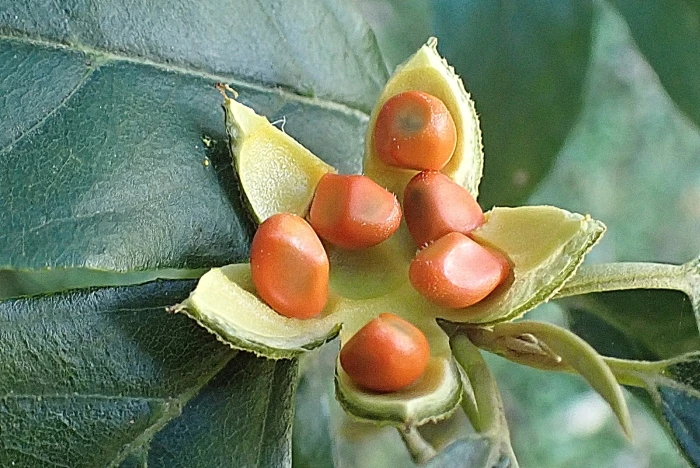Wild Peach
(Kiggelaria africana)
Wild Peach (Kiggelaria africana)
/
/

Di Turner
Public Domain
Image By:
Di Turner
Recorded By:
Copyright:
Public Domain
Copyright Notice:
Photo by: Di Turner | License Type: Public Domain | License URL: http://creativecommons.org/publicdomain/zero/1.0/ | Rights Holder: Di Turner | Publisher: iNaturalist | Date Created: 2021-04-24T13:50:29-07:00 |























































Estimated Native Range
Climate Requirements for Northdale, Florida
| This Plant | Your Site | Plant Suitability for Your Location | ||
|---|---|---|---|---|
| • Precipitation | 5" - 61" | 51" | Aquatic | Aquatic |
| • High Temp. | 64°F - 91°F | 91°F | Your summer temperatures are normal for this plant. | Excellent |
| • Low Temp. | 25°F - 58°F | 50°F | Your winter temperatures are normal for this plant | Excellent |
This plant may not grow well at your location - your precipitation is too high.
Summary
Kiggelaria africana, commonly known as Wild Peach, is an evergreen tree native to a variety of habitats including coastal forests, riverine bush, and woodland areas in Southern Africa. It typically grows to a height of 12-30 feet (4-9 meters) and a width of 9-25 feet (2.7-7.6 meters). The tree is characterized by its robust and well-shaped form, with grey-green leaves and smooth, pale grey bark. It produces inconspicuous yellow and green flowers in the spring and summer, followed by small, red fruits that attract a variety of birds and the Acraea horta butterfly, whose caterpillars are known to feed on the foliage.
Wild Peach is valued for its fast growth, hardiness, and ability to form a large shade tree with a gentle, non-invasive root system. It is versatile in cultivation, suitable for use as a windbreak, hedge, or as a specimen tree in gardens and parks. It thrives in full sun to part shade and requires moderate water, with the ability to survive frost. The tree’s non-aggressive roots and tolerance for different soil types with medium drainage make it an excellent choice for urban environments. While it is generally low-maintenance, shoots growing from the lower trunk should be pruned if a traditional tree shape is desired. Despite occasional defoliation by caterpillars, Kiggelaria africana is resilient and quickly regenerates its foliage, contributing to its ease of maintenance.CC BY-SA 4.0
Wild Peach is valued for its fast growth, hardiness, and ability to form a large shade tree with a gentle, non-invasive root system. It is versatile in cultivation, suitable for use as a windbreak, hedge, or as a specimen tree in gardens and parks. It thrives in full sun to part shade and requires moderate water, with the ability to survive frost. The tree’s non-aggressive roots and tolerance for different soil types with medium drainage make it an excellent choice for urban environments. While it is generally low-maintenance, shoots growing from the lower trunk should be pruned if a traditional tree shape is desired. Despite occasional defoliation by caterpillars, Kiggelaria africana is resilient and quickly regenerates its foliage, contributing to its ease of maintenance.CC BY-SA 4.0
Plant Description
- Plant Type: Tree
- Height: 12-30 feet
- Width: 9-25 feet
- Growth Rate: Moderate
- Flower Color: Yellow, Green
- Flowering Season: Spring, Summer
- Leaf Retention: Evergreen
Growth Requirements
- Sun: Full Sun
- Water: Medium
- Drainage: Medium
Common Uses
Bird Garden, Butterfly Garden, Hedges, Low Maintenance, Street Planting
Natural Habitat
Native to coastal forests, riverine bush, and woodlands in Southern Africa
Other Names
Common Names:
Scientific Names: Kiggelaria africana, Kiggelaria dregeana, Kiggelaria ferruginea, Kiggelaria flavo-velutina, Kiggelaria integrifolia, Acrophyllum obtusatum, Acrophyllum obtusum, Kiggelaria glabrata, Kiggelaria glandulosa
GBIF Accepted Name: Kiggelaria africana L.